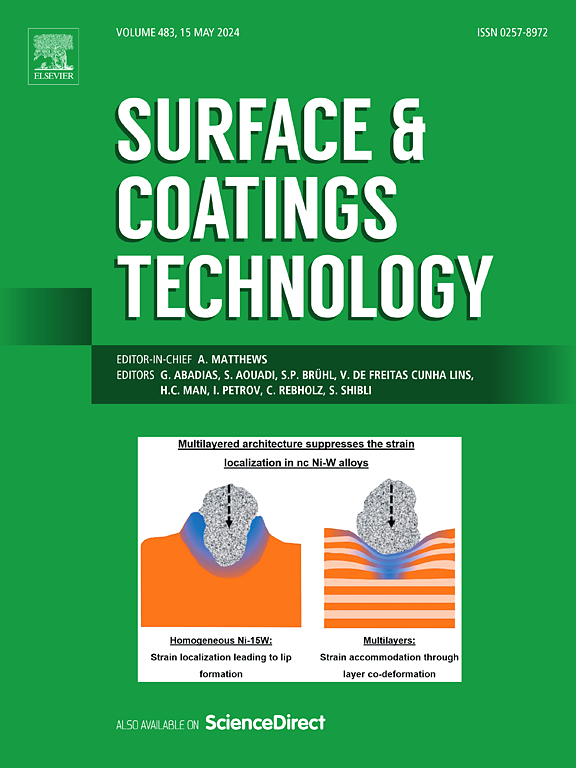高速激光熔覆高强钢涂层的裂纹缓裂及磨损性能
IF 5.3
2区 材料科学
Q1 MATERIALS SCIENCE, COATINGS & FILMS
引用次数: 0
摘要
本研究研究了利用高速激光熔覆(HSLC)技术制备无缺陷的高碳、富钒、富铬沉淀硬化马氏体钢涂层Rockit®606。与传统的激光熔覆相比,HSLC具有更高的沉积效率、更好的涂层质量、最小的热变形和更小的热影响区。各种HSLC参数-包括激光功率,行进速度,粉末进料速度和重叠距离-进行了优化,以获得优越的涂层性能。显微组织分析表明,在不考虑工艺参数的情况下,渗碳钢涂层中存在凝固裂纹。然而,通过减少热梯度,将基材预热到250°C有效地消除了开裂。涂层呈柱状枝晶结构,靠近基体的枝晶较粗,靠近表面的枝晶较细。硬度测量证实,所有涂层都明显超过了行业规定的60 HRC阈值,预热对整体硬度分布的影响最小。往复滑动磨损试验表明,与基线渗碳钢相比,无缺陷HSLC涂层的耐磨性有了显著提高。这些发现强调了HSLC在生产适用于工业应用的高性能耐磨涂层方面的潜力。本文章由计算机程序翻译,如有差异,请以英文原文为准。
Crack mitigation and wear performance of high-strength steel coatings deposited by high-speed laser cladding
This study investigates the fabrication of defect-free Rockit® 606, a high‑carbon, vanadium- and chromium-enriched precipitation-hardening martensitic steel coating, using high-speed laser cladding (HSLC). Compared to conventional laser cladding, HSLC offers higher deposition efficiency, improved coating quality, minimal thermal distortion, and a reduced heat-affected zone. Various HSLC parameters—including laser power, travel speed, powder feed rate, and overlap distance—were optimized to achieve superior coating properties.
Microstructural analysis revealed solidification cracks in coatings deposited on carburized steel, regardless of processing parameters. However, preheating the substrate to 250 °C effectively eliminated cracking by reducing thermal gradients. The coatings exhibited a columnar dendritic microstructure, with coarser dendrites near the substrate and finer dendrites towards the surface. Hardness measurements confirmed that all coatings significantly exceeded the industry-specified threshold of 60 HRC, with preheating having minimal effect on overall hardness distribution.
Reciprocating sliding wear tests demonstrated a substantial improvement in wear resistance for the defect-free HSLC coatings compared to baseline carburized steel. These findings underscore the potential of HSLC for producing high-performance, wear-resistant coatings suitable for industrial applications.
求助全文
通过发布文献求助,成功后即可免费获取论文全文。
去求助
来源期刊

Surface & Coatings Technology
工程技术-材料科学:膜
CiteScore
10.00
自引率
11.10%
发文量
921
审稿时长
19 days
期刊介绍:
Surface and Coatings Technology is an international archival journal publishing scientific papers on significant developments in surface and interface engineering to modify and improve the surface properties of materials for protection in demanding contact conditions or aggressive environments, or for enhanced functional performance. Contributions range from original scientific articles concerned with fundamental and applied aspects of research or direct applications of metallic, inorganic, organic and composite coatings, to invited reviews of current technology in specific areas. Papers submitted to this journal are expected to be in line with the following aspects in processes, and properties/performance:
A. Processes: Physical and chemical vapour deposition techniques, thermal and plasma spraying, surface modification by directed energy techniques such as ion, electron and laser beams, thermo-chemical treatment, wet chemical and electrochemical processes such as plating, sol-gel coating, anodization, plasma electrolytic oxidation, etc., but excluding painting.
B. Properties/performance: friction performance, wear resistance (e.g., abrasion, erosion, fretting, etc), corrosion and oxidation resistance, thermal protection, diffusion resistance, hydrophilicity/hydrophobicity, and properties relevant to smart materials behaviour and enhanced multifunctional performance for environmental, energy and medical applications, but excluding device aspects.
 求助内容:
求助内容: 应助结果提醒方式:
应助结果提醒方式:


